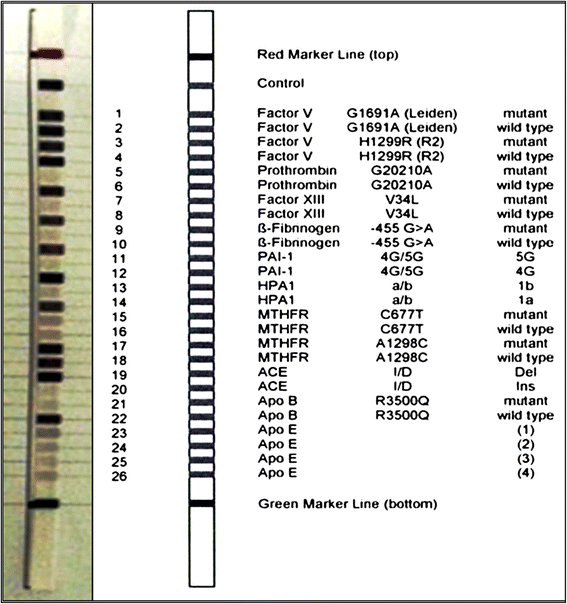Atherosclerotic and thrombotic genetic and environmental determinants in Egyptian coronary artery disease patients: a pilot study
- PMID: 28086795
- PMCID: PMC5237236
- DOI: 10.1186/s12872-016-0456-3
Atherosclerotic and thrombotic genetic and environmental determinants in Egyptian coronary artery disease patients: a pilot study
Abstract
Background: Coronary artery disease (CAD) is the leading cause of morbidity and mortality worldwide. Multiple genetic variants in combination with various environmental risk factors have been implicated. This study aimed to investigate the association of twelve thrombotic and atherosclerotic gene variants in combination with other environmental risk factors with CAD risk in a preliminary sample of Egyptian CAD patients.
Methods: Twenty three consecutive CAD patients undergoing diagnostic coronary angiography and 34 unrelated controls, have been enrolled in the study. Genotyping was based on polymerase chain reaction and reverse multiplex hybridization. Five genetic association models were tested. Data distribution and variance homogeneity have been checked by Shapiro-Wilk test and Levene test, respectively; then the appropriate comparison test was applied. Spearman's rank correlation coefficient was used for correlation analysis and logistic regression has been performed to adjust for significant risk factors. Clustering the study participants according to gene-gene and gene-environment interaction has been done by Detrended Correspondence Analysis (DCA).
Results: The univariate analysis indicated that the five variants; rs1800595 (FVR2; factor 5), rs1801133 (MTHFR; 5,10-methylenetetrahydrofolate reductase), rs5918 (HPA-1; human platelet antigen 1), rs1799752 (ACE; angiotensin-converting enzyme), and rs7412 and rs429358 (ApoE; apolipoprotein E) were significantly associated with CAD susceptibility under different genetic models. Multivariate analysis revealed clustering of the study population into three patient groups (P) and one control group. FVR2 was the most variant associated with CAD patients, combined with the factor V Leiden (FVL) variant in P1 cluster and with both ACE and MTHFR 667C > T in P2. Whereas, P3 was mostly affected by both MTHFR 667C > T and FXIII (factor 13) V89L mutations. When combined with traditional risk factors, P1 was mostly affected by dyslipidemia, smoking and hypertension, while P2 was mostly affected by their fasting blood sugar levels and ApoE variant.
Conclusions: Taken together, these preliminary results could have predictive value to be applied in refining a risk profile for our CAD patients, in order to implement early preventive interventions including specific antithrombotic therapy. Further large scale and follow-up studies are highly recommended to confirm the study findings.
Keywords: Coronary artery disease; Gene variants; Gene-disease interactions; Polymorphism.
Figures



References
-
- Raposo M, Sousa P, Nemeth S, Couto A, Santos M, Pinheiro J, et al. Polymorphism in cardiovascular diseases (CVD) susceptibility loci in the azores islands (Portugal) Open J Genet. 2011;1:48–53. doi: 10.4236/ojgen.2011.13009. - DOI
Publication types
MeSH terms
LinkOut - more resources
Full Text Sources
Other Literature Sources
Medical
Miscellaneous

